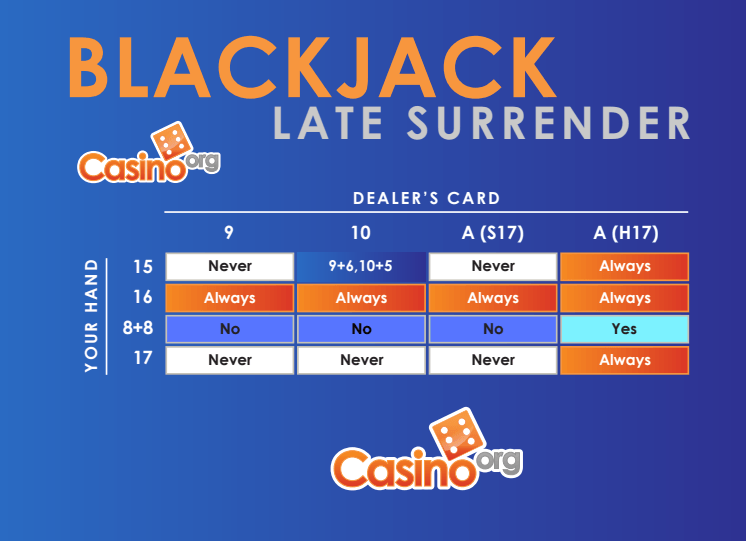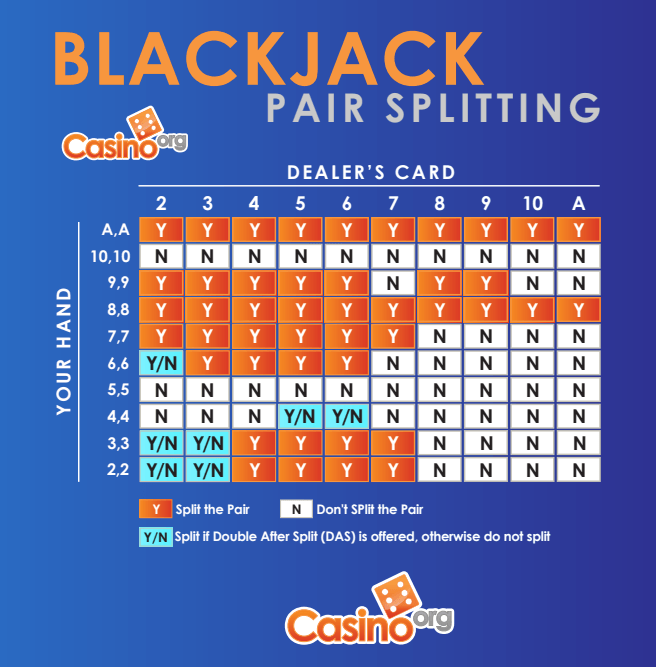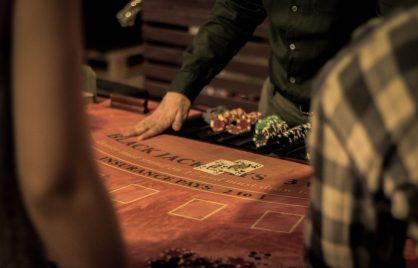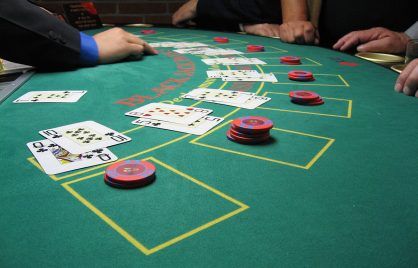Blackjack Strategy Charts: Play Perfect Blackjack
In blackjack, every decision you need to make has a mathematically correct answer. By using these basic strategy blackjack charts, you can ensure you always make decisions that keep the house edge as one of the smallest of any casino game.
Use our blackjack strategy charts in this order:
- First, look at surrender, if it’s even an option.
- Then, if you have pairs, consult the split chart.
- At that point, if you have a soft hand, meaning one of your cards is an ace, you will refer to the soft totals hit or stand chart.
- And finally, work your way to the hard totals hit and stand chart.
When you’re ready to play, simply download our free printable blackjack charts.
Blackjack Surrender Chart
Surrender isn’t always offered, and when it is, it’s usually what we refer to as Late Surrender. It’s the option to throw away your hand after the first two cards are dealt, and after the dealer has already checked for blackjack. If you choose to do this, you only lose half your bet.
In Early Surrender, you can choose to toss away your hand before the dealer checks for Blackjack. This can be a very powerful but seldom-seen rule change. In the chart above, I am referencing Late Surrender.
- Basically, with 15 you surrender against a 10, but only if it’s not made up of the 8 and 7.
- You always surrender any 16, other than a pair of 8s against a dealer up card of 9, 10 or 11.
- With a pair of 8s, you only surrender against a dealer ace if the rule requires them to hit soft 17.
- With a 17, you only surrender against an ace.
Blackjack Split Chart
When you split, you must be aware of whether you can then double if you get dealt two cards that our chart tells you to double. This is simply called Double After Split (DAS).
In the above chart, you should only split the hands highlighted in blue if the game rules you are playing do, in fact, allow you to double after the split; otherwise, move on to the Hit/Stand tables.
- You always split aces and 8s.
- 9s are split against everything but a 7, 10 or an ace.
- 7s are split against 2 through 7.
- 6s are split against 2 through 6, though against a two up you should really only split if you are allowed to double after.
- Never split 5s.
- Only split 4s against a 5 or 6 if you are allowed to Double After Split.
- With 2s or 3s, only split against 2 and 3 if you can DAS, and against 4 through 6 regardless.
Hit or Stand Chart – Soft Totals
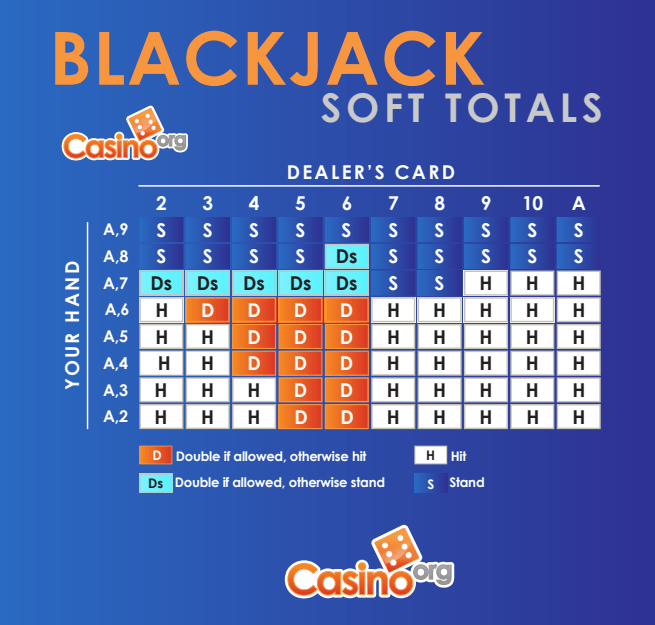
Use this chart if one of your cards is an ace. But, before we get into whether to hit, stand or double with a soft hand, note that some blackjack games only allow you to double certain cards like 10 or 11. My advice is to stay away from those games. You will see our blackjack hand chart notes to double if allowed.
- With A2 and A3, you should double against a 5 or 6, otherwise hit.
- With A4 and A5, double against 4, 5 or 6, otherwise hit.
- With A6, you can double against 3 through 6.
- With A7, you can double against 2 through 6, stand against 7 or 8, and hit against 9, 10, ace.
- With the A8, you double against a 6 and stand on everything else.
- And with A9, you stand against everything.
Hit or Stand Chart – Hard Totals
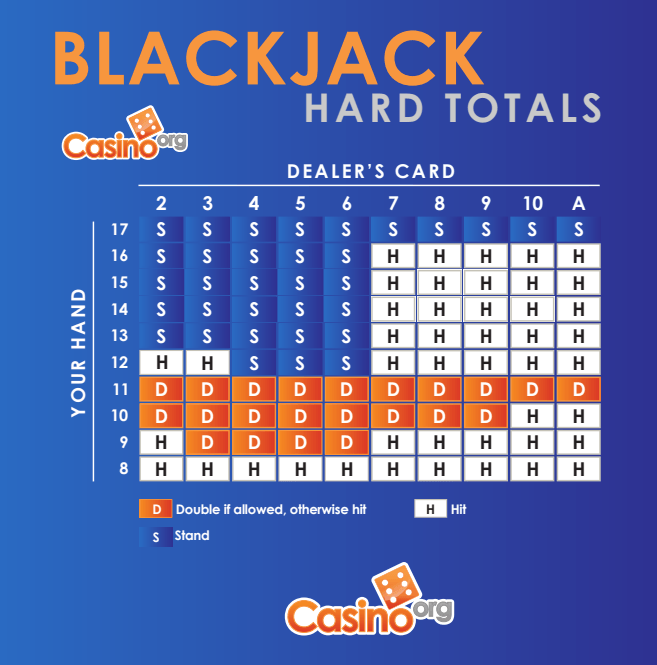
A hard total is a hand that does not contain an ace.
Low hands (5 through 8) that aren’t pairs or soft hands are hit until at least twelve, regardless of the up card. Then, once we get to twelve, we can begin to use our blackjack basic strategy chart. You will double down some 9,10, and 11 value hands.
- 9s are doubled against a 3 through 6 up card. Otherwise, you hit.
- 10s are doubled against the dealer’s 2 through 9. Otherwise, you hit.
- And with a total of 11, you always double.
- With hands totaling 12, stand on 4, 5 or 6. Otherwise hit.
- With a 13, 14, 15 or 16, stand against 2 through 6 and hit the rest.
- On any other hand with totals of hard 17 or more, you stand.
Printable Blackjack Charts
Use our printable blackjack strategy charts to make it easy to remind yourself of the best move to make when next playing online or in a casino. Just hit download to save each individual blackjack chart PDF to your phone or desktop, ready to refer to whenever you need them. Or, once downloaded, use the printer icon to print the PDFs.
FAQs About Basic Blackjack Strategy Charts
What is a blackjack strategy chart?
A basic blackjack strategy chart tells us exactly how to play each hand in the mathematically correct way. This information is presented in an easy-to-understand chart that shows how to play each hand.
How do you read a blackjack chart?
It’s important to remember that we need to walk through the hand in a certain order. Surrender if allowed, splitting pairs, playing soft hands, double downs, and finally, hitting or standing. The dealer’s up card is across the top, your hand is on the left-hand side, and the table is filled with how to play that exact hand.
Are blackjack charts allowed in casinos?
Yes! You can always use your blackjack chart whether you’re at a casino or playing blackjack online. Playing these hands perfectly will make a big difference to your bottom line, so never be ashamed about using a blackjack cheat chart to help you.
What is the best blackjack strategy?
The best strategy can change based on the number of decks being used and various rule changes from one casino to the other. These slight changes can alter how our blackjack strategy chart looks and how you should play. For more on blackjack strategies, read our in-depth guide.
Should you always hit 12 in blackjack?
The math is very clear: you want to hit a 12 against a dealer 12 or 13, and honestly, it’s really a coin flip against 14. Many folks may disagree, but I wouldn’t lie to you, and neither will your strategy chart.
Why not put these charts to the test and practice playing blackjack for free? And then play online blackjack for real money when you’re ready.
